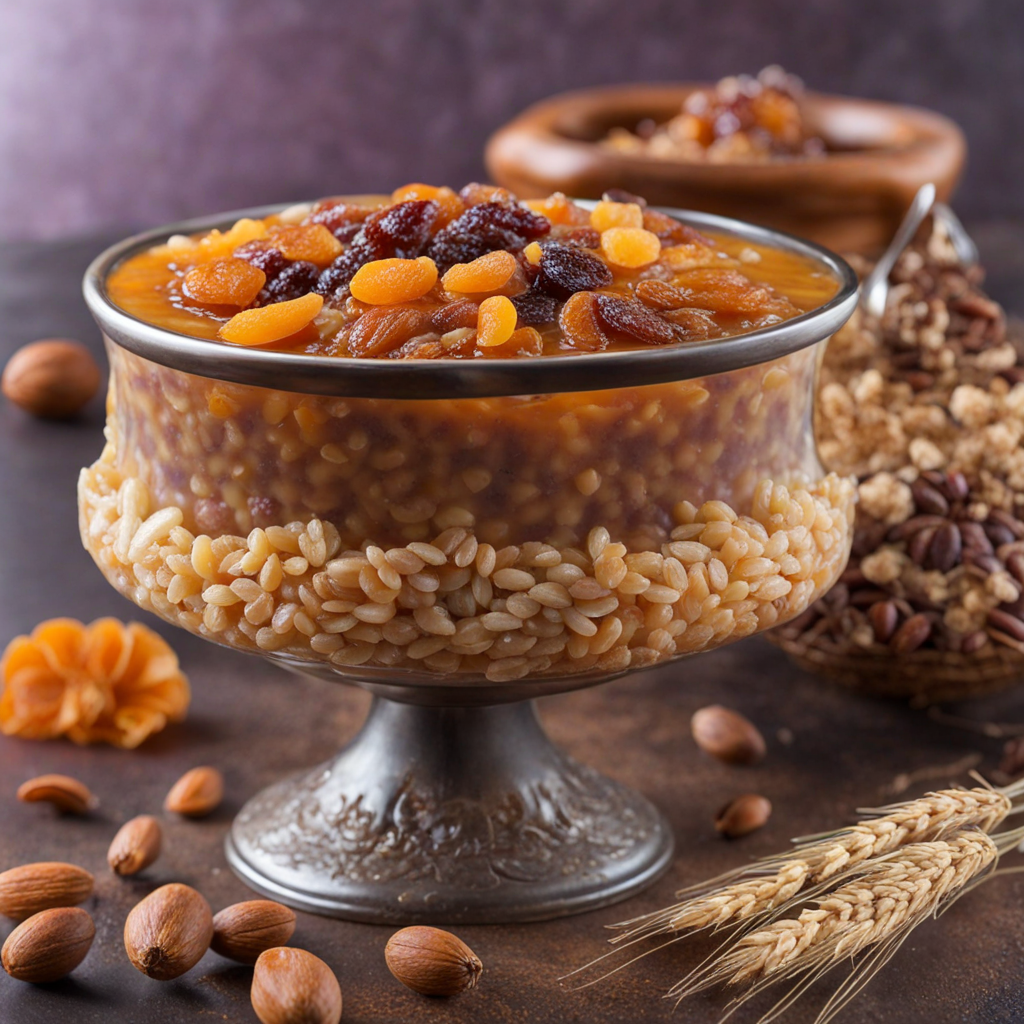Anushabur
Anushabur is a traditional Armenian dish that embodies the rich flavors and cultural heritage of the region. This delightful dessert is primarily made from a base of wheat, which is boiled and then mixed with various ingredients such as sugar, cinnamon, and nuts. The combination of these elements creates a thick, porridge-like consistency, offering a comforting and hearty experience. The sweet and nutty notes are beautifully balanced, making it a perfect treat for those with a penchant for desserts that are both rich and wholesome. One of the standout features of Anushabur is its versatility, as it can be customized with different fruits, such as dried apricots or raisins, which add an extra layer of flavor and texture. Additionally, the dish is often garnished with ground walnuts or almonds, enhancing its nuttiness and providing a satisfying crunch. The fragrant spices, particularly the warm hints of cinnamon, elevate the dish, making it a fragrant and inviting option for a variety of occasions. Traditionally served during significant Armenian celebrations, Anushabur not only delights the palate but also carries a deep cultural significance. It is often associated with the harvest season, symbolizing abundance and gratitude. Whether enjoyed warm or chilled, this dessert offers a unique culinary experience that transports you to the heart of Armenia, inviting you to explore the rich tapestry of flavors and traditions that define this beautiful cuisine.
How It Became This Dish
Origins of Անուշաբուր The traditional Armenian dessert known as Անուշաբուր (Anushabur) has a rich history rooted in the agricultural practices and culinary traditions of Armenia. The name itself can be translated as "sweet porridge," which aptly describes its texture and flavor. This dish is believed to have originated in ancient times, during the early periods of Armenian civilization, when agriculture began to flourish in the fertile highlands of the region. The primary ingredients of Anushabur include wheat, sugar, and various nuts and dried fruits, which reflect the abundance of these resources in the Armenian landscape. The dish's foundation lies in a simple grain porridge, but it has evolved through the centuries, incorporating various local flavors and seasonal ingredients, making it a versatile and cherished part of Armenian cuisine. Cultural Significance Anushabur holds a special place in Armenian culture, often associated with celebrations, feasts, and significant life events. It is traditionally prepared during the holiday of Vardavar, which celebrates the transfiguration of Christ, and also during the harvest festival of Khachkar. The dish symbolizes abundance and prosperity, as it showcases the region's agricultural bounty. In family settings, Anushabur is often served during significant occasions, such as weddings and christenings, where the dish is not only a treat for the taste buds but also a representation of blessings and good fortune. Its sweet and comforting nature makes it a popular choice for gatherings, serving as a reminder of the warmth of Armenian hospitality. Ingredients and Preparation The basic preparation of Anushabur involves boiling wheat grains until they become soft and creamy. Once the wheat is cooked, sugar is added, along with a variety of ingredients such as raisins, apricots, or walnuts, depending on regional variations and personal preferences. Some families incorporate spices like cinnamon or cardamom, which further enrich the dish's flavor profile. What sets Anushabur apart from other grain-based desserts is its texture—a harmonious blend of creaminess and chewiness. The porridge is often finished with a drizzle of honey or a sprinkle of toasted nuts on top, enhancing its sweetness and providing an additional layer of flavor. This careful balance of ingredients and techniques showcases the Armenian culinary tradition of creating dishes that are both nourishing and delicious. Evolution Through Time As Armenia has undergone various cultural influences and historical changes, so too has the recipe for Anushabur. The dish has adapted to incorporate new ingredients brought by traders and travelers who passed through the region, such as sugar cane and exotic spices from the East. This evolution reflects the dynamic nature of Armenian cuisine, which is always adapting while remaining rooted in its history. In the 19th and 20th centuries, as Armenians migrated to different parts of the world, Anushabur was carried along, leading to unique adaptations in diaspora communities. In places like the United States, France, and Russia, Armenian families began to modify the recipe based on available ingredients, yet the essence of Anushabur remained intact. The dish became a sentimental reminder of home, bridging the gap between generations and preserving cultural identity in a foreign land. Regional Variations Different regions in Armenia have developed their own versions of Anushabur, each with distinctive twists that reflect local tastes and customs. For instance, in the mountainous regions, people often add a pinch of local herbs or foraged greens to the mix, while coastal areas might incorporate fresh fruits or a splash of fruit juice for a fresher flavor. In addition, festive occasions may prompt families to add special ingredients such as pomegranate seeds, which add a pop of color and a tangy contrast to the sweetness. In recent years, health-conscious variations have emerged, utilizing whole grains or natural sweeteners, demonstrating the dish's adaptability to contemporary dietary preferences without losing its cultural roots. Contemporary Relevance Today, Anushabur continues to be a beloved dish among Armenians both in Armenia and in the diaspora. With the rise of interest in traditional foods and sustainable cooking practices, many young chefs are revisiting ancestral recipes and highlighting dishes like Anushabur in their menus. Food festivals and cultural events often feature Anushabur as a symbol of Armenian heritage, where it is presented alongside other traditional dishes. Moreover, social media has played a significant role in revitalizing interest in Anushabur, with food bloggers and home cooks sharing their variations and stories related to the dish. This digital platform has facilitated a global conversation about Armenian cuisine, allowing people to connect through shared recipes and memories, ensuring that Anushabur remains a cherished part of both personal and communal identity. Conclusion: A Culinary Legacy Anushabur is more than just a dessert; it is a representation of Armenian culture, history, and resilience. As it has evolved and adapted through the centuries, it has maintained its significance as a dish of celebration and comfort. Whether enjoyed during a festive gathering or as a comforting family treat, Anushabur encapsulates the spirit of Armenian hospitality and the enduring legacy of a rich culinary tradition. Through its delicious flavors and cultural connections, Anushabur continues to inspire future generations, reminding Armenians around the world of their roots and the importance of food in preserving cultural identity. The dish stands as a testament to the power of tradition, community, and the love that goes into preparing and sharing food.
You may like
Discover local flavors from Armenia







